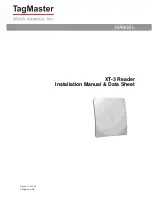
Chapter 8
Counters
8-24
ni.com
Yo
u
also can
u
se the Gate inp
u
t of the co
u
nter as a Pa
u
se Trigger (if it is not
u
sed as a Start Trigger). The co
u
nter pa
u
ses p
u
lse generation when the
Pa
u
se Trigger is active.
Fig
u
re 8-25 shows a contin
u
o
u
s p
u
lse train generation (
u
sing the rising
edge of So
u
rce).
Figure 8-25.
Continuous Pulse Train Generation
Contin
u
o
u
s p
u
lse train generation is sometimes called freq
u
ency division.
If the high and low p
u
lse widths of the o
u
tp
u
t signal are
M
and
N
periods,
then the freq
u
ency of the Co
u
nter
n
Internal O
u
tp
u
t signal is eq
u
al to the
freq
u
ency of the So
u
rce inp
u
t divided by
M
+
N
.
For information abo
u
t connecting co
u
nter signals, refer to the
section.
Finite Pulse Train Generation
This f
u
nction generates a train of p
u
lses of predetermined d
u
ration. This
co
u
nter operation req
u
ires both co
u
nters. The first co
u
nter (for this
example, Co
u
nter 0) generates a p
u
lse of desired width. The second
co
u
nter, Co
u
nter 1, generates the p
u
lse train, which is gated by the p
u
lse of
the first co
u
nter. The ro
u
ting is done internally. Fig
u
re 8-26 shows an
example finite p
u
lse train timing diagram.
Figure 8-26.
Finite Pulse Train Timing Diagram
S
OURCE
OUT
Co
u
nter Armed
Co
u
nter 0
(P
a
ired Co
u
nter)
Co
u
nter 1
Gener
a
tion
Complete
















































